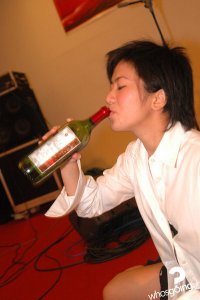




PHOTOS:
Stormy Sky Over Saint-Emilion
View on St-Emilion From the Place du Clocher
The Gates to Chateau Canon Vineyards (see Church in the Far)
Kilometers of Galleries
St Emilion, Old Walls and Vineyards
You might consider the town of Bordeaux as the natural base for this exploration, but the traffic around and in Bordeaux is a challenge. The better option is to stay first a few days in Bordeaux, then find a base out of town to visit the area. Leaving or entering the Bordeaux limits by car can be a misery because lots of commuters live out of town and drive to work, and the freeways are often jammed. In Bordeaux itself you can walk or use its new glitzy tramway to feel the pulse of this great wine capital. Like every other rich town in France, Bordeaux succumbed to the tramway craze and bought itself this new costly toy. Riding in its cars will give you a good first approach of this magnificent town where wine is a major and historic cornerstone. Speaking of the tramway, a trolleybus system would have been cheaper, more silent and allow more flexibility in its itineraries, but a trend is a trend... Apart from the economic soundness of this new tramway, the outlook of the town improved much after this major remodeling project.
There are quite a number of good hotels in Bordeaux and we've used in the past both the Continental Hotel (doubles : 85 or 104 Euros)which is centrally located (we're giving these addresses without sponsorship...), and the very cheap Hotel F1 chain (33 Euros a room - all rooms can accomodate 1, 2 or 3 people)), which is located on the other side of the Garonne, at a 15 mn walking distance from downtown (they have a parking). You can reserve you Hotel F1 room through the internet (they're very basic but good value and fill up fast).
We'll skip the Bordeaux visit this time and concentrate on St-Emilion which is a good base to visit the region.
In spite of having all the features of a wine-tourist trap (like Beaune in Burgundy), with its collection of luxury wine shops and well-polished old streets, Saint Emilion is still a lovely place from which you can plan your exploration of the Bordeaux region without being bothered by the traffic. Once in Saint-Emilion, try not to loose your time with window shopping on wine paraphernalia that you'd probably find anywhere in the world, and start your time travel in this lovely small town...
To find an accomodation in or near St Emilion, you can look for a Chambre d'Hôte (B&B) on the web, like this page, or on that page. Many of these chambres also have a "table d'hôte", meaning that you can have dinner with the owners at a very reasonable price, and probably discover their favorite wine at the same occasion. Check the distance of the accomodation from St Emilion and use Viamichelin to locate the given village on the map (you need the ville/village name and its zip code).
Saint-Emilion is an extremely-well preserved village and walking along its streets is a pleasure. As it is sitting at the top of a hill, you have several spots with nice views over the town's roofs and the vineyards, like from the Place du Clocher near the Tourism Office. This "Office du Tourisme" provides the visitors with lots of info about the town and the wineries. St Emilion is literally encircled by vineyards, and some of the estates around St-Emilion were first planted by the Romans. The Roman Poet ausone for example, owned one of the three properties of his time, including what has become Chateau Ausone. I can't but recommend an excellent guide book to vist the area, it is Hubrecht Duijker's Touring in Wine Country, Bordeaux (a collection directed by Hugh Johnson). The French edition seems to be sold out but you should find the English version. Its many maps covering each of Bordeaux Appellations are so detailed that you can easily find the properties yourself, and these maps will also be of great help to understand the Appellations and locate the estates and their neighboors. Many world-renowned estates are at an easy walking distance of the village, like Chateau Ausone, Chateau Bel Air, Clos Fourtet, Chateau Canon or Chateau Beauséjour Duffau. Take the right street and path, and you can be walking along Ausone's vineyards or Chateau Canon's in the matter of 5minutes after leaving the Place du Clocher.
When you begin your vist of St-Emilion and its region, you may try the tourist train (see picture right), it costs 5 Euro per person and drives you around St Emilion with a multi-language description of the landscape and estates it drives by. Not a must-do experience, especially if they keep the glass-windows on (actually it's cheap for a sauna) like when we took it, and once you'll venture on foot outside of Saint-Emilion, you'll realize that you can do the itinerary yourself by foot. Also, the operators of this train seem to direct the tourist on certain wineries along the circuit where a tasting room and a shop welcomes the visitors, and I am not sure these wineries are the most interesting ones.
Another good option to explore thearea is to rent a bicycle. You can ask at the Tourist office near the Place du Clocher, according to this page, they have bicycles to rent. The Chambre d'Hôte where you stay may also have a few bicycles for your own use (like the Chambre d'Hôte of Chateau Meylet), and that may be one of the things to ask before choosing your accomodation. You can also join of of these costly packages where your bicycle tour is organized through several points of interest and estates, like here. If you are an experienced cyclist and feel that you can travel on your own bicycle like this fellow on left, prepare your gear (don't forget the rain coat) and take the road from Bordeaux, your trip will be very rewarding especially if you keep using the small roads. See this page for a few tips.
The cats of Saint emilion are either wine snobs, or really, really spoiled... Somehow the wine craze has crossed the species boundaries in St Emilion and I shot red-handed (red-clawed ?) this one as it was sharpening its claws on...a vine right in the tiny garden of a local wine shop. The wine shop in question is the Comptoir des Vignobles and there are a few wine shops of this quality in the village, they all seem well stocked with tempting bottles. Several of them have a few open bottles for tasting, and as the top estates don't sell wine at the estate in Bordeaux, it may be interesting to make a few purchases if you can afford it (we can't). These shops stock old millesimes too and the rule is to be impressed by the price tag of the top estates. Great place to buy a bottle and have it with friends sitting in the vineyards.
St Emilion sits on kilometers of caves and man-made galleries, and the size on this underground world is such that only a small proportion is used as wine cellar. The picture above was shot on the small road leading to Chateau Bel air.
In St Emilion proper, you still find authentic streets and places if you venture out of the beaten path. It is a good surprise to see these simple scenes, untouched by the wine & luxury culture. We walked along this "rue des Douves" [pic on left] as we came back from our stroll near Chateau Canon and Chateau Ausone. Very quiet walk, we were basically alone. I noticed the many fig trees in the area and must confess that I picked a small branch from a fig tree on Ausone property, with the goal to have it grow in the Loire. I'm not sure it will work yet, I'll keep you informed. Whatever, we came back to St Emilion through this narrow street bordered with many unused caves and underground galleries, some of them being walled. These galleries were initially quarries, not cellars. A nice smell of freshness and cold rock cellar came to us as we walk along this quiet path.
Saint Emilion has been largely spared by modern constructions and it is a pleasure to walk straight from the old city to prestigious vineyards. The vineyard on the picture belong (if I'm right) to Clos Fourtet. The wall on the right is a remain of the fortifications that were protecting the city from invaders. Don't ask me too many details, I think it was the English armies, and there has been some rough battles in the vicinity.There are a couple of wine bars, the most well-known being near the office du tourisme. The one we went to is a bit off-center, it is named Chai Pascal on the rue Gaudet, and it has a connected computer in addition to a few nice wines. I overheard a few conversations there and it seems that some estate owners are regulars. So if you want to hear insider news and spy on the region, that may the place to go. I just found a positive review (in French) on this cool place.
That's one of the reasons I prefer the slow travel to the fast TGV trains (the other being it is much cheaper) : We saw this herd as we were leaving the region and driving northward in the direction of Limoges on secondary roads. At precisely the time we stoped for a few minutes, three herd boys arrived to move the animals to another prairie, the oldest, in his mid 40s, had long dark hair and a several-days-old beard and looked as if he lived in a remote place in the backcountry. He was visibly teaching a maybe-15-year-old future herd-keeper on how to prepare carefully a herd to move. I regret not to have asked for a picture but felt it would break the magic, plus I'm not sure they would have accepted.
Bertrand Celce



